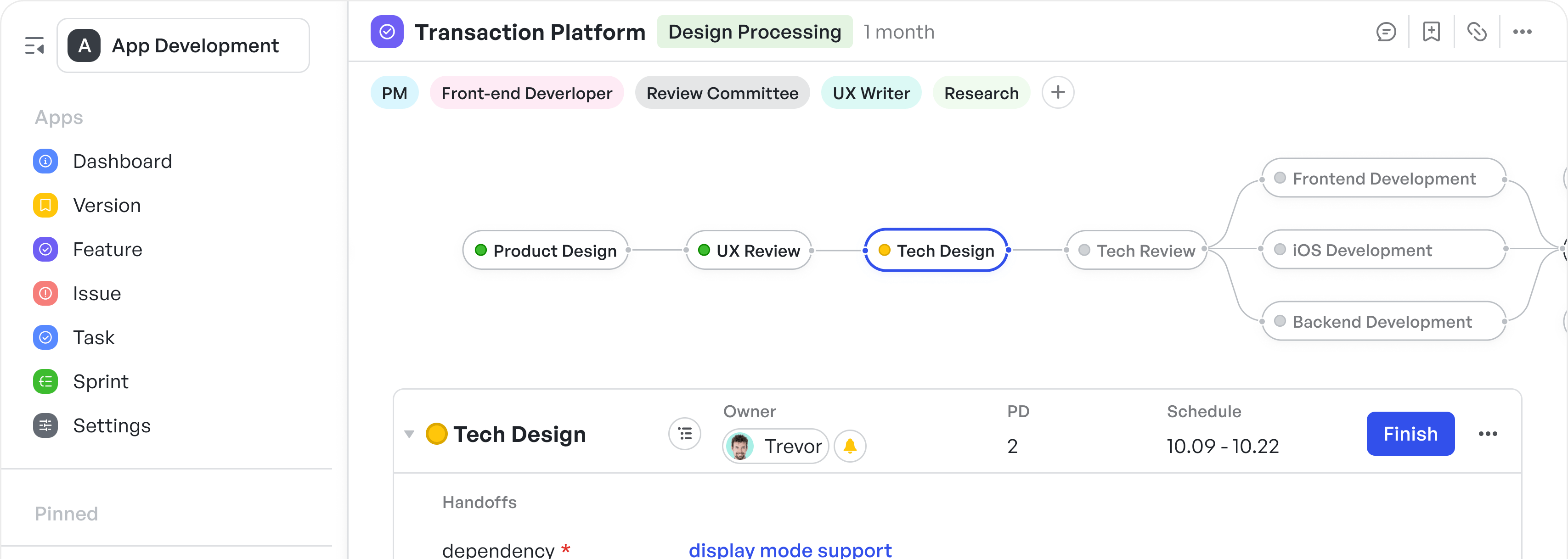Imagine your team is working on a big project. Some people prefer a simple, visual way to manage tasks. Others need detailed workflows and reports to stay on track. That’s where Trello and Jira come in. There are two popular tools that help teams organize their work but in very different ways.
Trello makes managing tasks easy with its boards and cards. It’s great for quick, visual planning. Jira, on the other hand, is perfect for teams with complex projects. It’s built for detailed workflows and agile methods like Scrum and Kanban.
But what if you could have the best of both worlds? That’s where Meegle comes in, offering a new way to manage work that combines Trello’s simplicity with Jira’s power.
In this guide, we’ll look at how Trello, Jira, and Meegle compare and help you decide which one fits your team—or how you can use them together to get even better results.
Trello’s best features for flexible workflow management
250px|700px|reset
加载中,请稍后
Trello - project management tool (Source: Trello)
Trello makes organizing work feel natural, whether you’re managing a team project or tackling personal tasks. Its simplicity improves collaboration and brings clarity to the chaos of daily workflows.
Key features
- Kanban boards
250px|700px|reset
加载中,请稍后
Manage client workflow in Trello (Source: Trello)
Trello’s Kanban boards offer a simple yet effective way to visualize and manage tasks. Each board consists of customizable lists, typically representing stages like To Do, In Progress, and Done. Users can create individual cards for tasks, which can be moved between lists to reflect progress.
The drag-and-drop interface makes it intuitive, allowing teams to adapt workflows to meet their specific project needs. It’s particularly useful for teams managing small projects or personal task tracking.
- Power-Ups
250px|700px|reset
加载中,请稍后
Checklist summary in Trello (Source: Trello)
Trello’s Power-Ups extend the platform’s functionality by integrating with popular tools like Slack, Google Drive, and Microsoft Teams.
For example, the Slack Power-Up allows you to send updates or receive notifications directly in Slack channels, ensuring seamless communication. The Google Drive Power-Up enables attaching files and folders directly from Drive, making it easier to access relevant resources. Teams can choose from hundreds of Power-Ups to enhance productivity and collaboration.
- Due dates and reminders
250px|700px|reset
加载中,请稍后
Set due dates and reminders in Trello (Source: Trello)
With Trello, users can set due dates for individual cards, ensuring deadlines are clear and manageable. Notifications are sent as reminders as deadlines approach, helping users stay on top of tasks.
These reminders are automated and can be customized, making them essential for prioritizing work and keeping projects on track. The feature is ideal for teams juggling multiple tasks simultaneously.
- File sharing
250px|700px|reset
加载中,请稍后
Share files in easy steps in Trello (Source: Trello)
File sharing in Trello simplifies collaboration by allowing users to attach documents, images, or other files directly to task cards.
For example, a marketing team can upload campaign assets to a card for easy access by all team members. Files can be added from your local drive or through integrations like Google Drive or Dropbox. This eliminates the need for separate file-sharing platforms and centralizes information within the project workspace.
- Free version
250px|700px|reset
加载中,请稍后
Start your journey with Trello's free plan (Source: Trello)
Trello’s free plan provides comprehensive functionality for individuals and small teams. It includes unlimited cards, up to 10 boards per workspace, and basic Power-Ups.
While it’s not as feature-rich as the paid plans, the free version offers enough tools to manage straightforward projects effectively. Small businesses or freelancers can use it to keep track of tasks without incurring additional costs
Trello shines with its simplicity, making it ideal for teams handling straightforward projects or seeking a Kanban style project management tool. See how it compares to other tools like Meegle.
How to use Trello within your organization
Project managers gravitate toward Trello because it makes workflows visible and progress tangible. The setup is straightforward, and the impact is immediate.
Onboarding and setup
- Create a board: Start with a Kanban board for your team or specific projects.
- Add lists: Structure workflows with lists like To Do, In Progress, and Done.
- Customize cards: Add task details, due dates, attachments, and labels for clarity.
- Enable Power-Ups: Integrate tools (like Google Drive) to enhance collaboration and efficiency.
Best practices for Trello
- Define workflows: Set transparent processes for moving tasks between lists (e.g., review stages).
- Assign tasks: Use the “@” mentions to assign responsibility to team members.
- Keep boards updated: Encourage team contributions to reflect real-time progress.
- Track project progress: Use labels and checklists to visualize milestones and priorities and get deeper insights into ongoing work.
Trello speaks to teams looking for clarity, momentum, and simplicity in project management. It unlocks potential, allowing teams to focus less on process and more on delivering results.
Jira’s top features for agile project management
250px|700px|reset
加载中,请稍后
Jira - project management tool (Source: Jira)
Jira goes beyond plain project management and works as a framework agile teams depend on. Unlike Trello, Jira has more powerful tools for managing complex workflows and tracking every detail of the project's progress.
For software teams and large organizations, Jira serves as the engine that drives bug tracking, sprint planning, and the seamless flow of tasks.The choice isn’t random. It reflects a need for tools that enable control, customization, and continuous delivery.
With Jira, the project focus is agile, allowing teams to plan, monitor and deliver work more productively. The software includes features like a Scrum board and velocity chart, designed for high performance.
Let’s explore the key features that make Jira useful for product managers and business teams alike.
Key features
- Kanban and Scrum boards
250px|700px|reset
加载中,请稍后
Kanban board overview in Jira (Source: Jira)
250px|700px|reset
加载中,请稍后
Scrum board overview in Jira (Source: Jira)
Jira offers built-in Scrum and Kanban boards tailored for agile project management.
Scrum boards are perfect for sprint planning, enabling teams to break down work into sprints with clear timelines and goals. Kanban boards, on the other hand, are more flexible and help visualize workflows for teams focused on continuous delivery.
Both types of boards come with features like WIP (work-in-progress) limits, ensuring team members focus on priority tasks.
- Advanced reporting
250px|700px|reset
加载中,请稍后
Data-driven reporting in Jira (Source: Jira)
Jira’s reporting tools provide actionable insights into project performance. Reports like burndown charts, velocity charts, and cumulative flow diagrams help teams analyze sprint progress, identify bottlenecks, and plan future iterations.
For example, the velocity chart gives an overview of the team’s capacity and productivity across sprints, while the burndown chart tracks the remaining work against time. These visualizations are invaluable for agile teams looking to refine their processes and improve efficiency.
- Bug tracking
250px|700px|reset
加载中,请稍后
Track bugs from backlog to done in Jira (Source: Jira)
Jira is renowned for its comprehensive bug-tracking capabilities. Teams can create detailed bug tickets, assign them to specific members, and prioritize them based on severity.
The system allows users to link bugs to related tasks or user stories, ensuring transparency and traceability. Additionally, features like custom workflows and status updates make it easy to monitor a bug’s lifecycle from identification to resolution.
- Highly customizable workflows
250px|700px|reset
加载中,请稍后
Create customizable workflows in Jira (Source: Jira)
Jira allows teams to design workflows tailored to their unique processes. For example, software development teams can create custom statuses such as Code Review, Testing, or Deployed.
Workflow rules can automate transitions, such as moving a task to In Progress when it’s assigned or to Done when a pull request is merged. This customization ensures workflows align with organizational practices and improves team efficiency.
- Integration with third-party apps
250px|700px|reset
加载中,请稍后
Integrate Jira with third-party apps (Source: Jira)
Jira supports seamless integration with tools like GitHub, Bitbucket, Slack, and Confluence. For instance, developers can link Jira issues to GitHub pull requests, enabling real-time updates on code progress within Jira.
Similarly, Slack integration allows notifications and updates to be shared in team channels, enhancing collaboration. These integrations create a connected ecosystem that boosts productivity by reducing the need to switch between platforms.
Jira’s versatility and depth make it an essential project management tool for software teams tackling complicated projects.
Step-by-step guide to using Jira within your organization
Jira is built to support agile teams balancing fast development cycles with evolving project scopes.
Here’s a step-by-step guide to effectively setting up and using Jira within your team or organization.
- Launch a new project
Begin with a Kanban or Scrum board, depending on your team’s workflow. Each serves as a blueprint for managing tasks and visualizing progress. Scrum boards break work into sprints, while Kanban boards track ongoing tasks.
- Define workflows
Create workflows that mirror how your team operates. Set up stages such as To Do, In Progress, and Done, or get custom phases like Testing or Under Review to match project demands.
- Create and assign issues
Jira’s issue-tracking system is at the heart of its functionality. Create issues for each task, bug, or feature and assign them to the relevant team members.
You can define user stories and sprints for agile projects to map out work over specific intervals.
- Plan sprints
Sprint planning is a key aspect of agile project management. In Jira, you can break your work into sprints, where team members focus on completing tasks within a fixed time frame (e.g., two weeks).
You can easily manage your backlog and prioritize tasks in Kanban or Scrum boards.
- Track project progress
Use Jira’s built-in advanced reporting tools to track the status of your project and individual tasks. These include velocity charts, burndown charts, and time tracking to monitor the amount of work completed and the remaining tasks.
- Manage user stories and epics
For more complex projects, break down your tasks into Initiative 01 and Initiative 02. This allows you to track long-term goals while focusing on short-term deliverables.
- Collaborate and communicate
Jira facilitates collaboration between team members by allowing real-time updates, comments, and notifications. With integrations like Slack, teams can stay on top of changes instantly.
- Use Jira’s integrations
Integrate with several third-party tools like GitHub, Bitbucket, or even Slack, so developers can push their updates from the development environments to Jira.
Jira’s agile project management features encourages teams to break down complexity, tackle challenges head-on, and pursue continuous improvement. It’s ideal for large-scale projects that require advanced features and tight collaboration.
Trello vs Jira: Which project management tool should you choose?
Choosing between Trello and Jira depends on knowing how your team operates, the complexity of your projects, and the systems that drive your success. Both tools are powerful, but their features cater to different use cases.
Let’s break down the decision-making process to help you identify the best fit for your team.
Factors to consider when choosing between Trello and Jira
The final-pick decisions often hinges on how each tool's strength aligns with your team's operational dynamics and long-term objectives.
Factors such as the nature of your projects, the structure of your team, and your future growth aspirations can reveal which platform will be situationally better.
When to choose Trello
- Your projects are relatively simple.
- You need an intuitive and user-friendly interface.
- Your team is small or managing personal projects.
- You require lightweight project management software for brainstorming or to-do lists.
- Cost is a significant factor, and you’d benefit from Trello’s free version.
When to choose Jira
- Your team handles complex projects or software development.
- You need comprehensive features like time tracking, bug tracking, and detailed advanced reporting.
- Agile methodologies such as scrum and sprint planning are central to your workflow.
- Your team requires customizable workflows and Jira work management capabilities.
- You’re part of a large organization or managing multiple software teams.
Meegle: Combining Trello’s simplicity with Jira’s precision
250px|700px|reset
加载中,请稍后
Meegle - Project Management Tool of the Next Gen
Some teams prefer the simplicity of Trello, while others require the precision and depth of Jira. Meegle caters to teams that appreciate Trello's ease of use but also need the advanced features and capabilities that Jira offers.
For teams navigating the space between streamlined task management and fully-featured project oversight, Meegle delivers the clarity Trello provides with the functional power Jira commands. It removes barriers, allowing teams to operate at their best without the friction of steep learning curves or overwhelming setups.
Visual workflows: The key differentiator
250px|700px|reset
加载中,请稍后
Start with a ready template in Meegle
What defines Meegle is its features that translate into action. Visual workflows enhance the way teams interact with tasks. Kanban boards simplify daily operations, while scrum boards drive more detailed project cycles. Progress is seen, felt, and tracked in real time, fostering collaboration and reducing the clutter that often hinders momentum.
Trello vs. Jira: 4 Reasons Why Meegle is an excellent alternative
- Streamlined user experience
250px|700px|reset
加载中,请稍后
Connect all tasks in a streamlined way in Meegle
Where Jira has anoverwhelming setup, Meegle offers an intuitive interface that’s easy to learn. It provides an easy transition for teams outgrowing Trello, offering a natural progression for those looking to scale their projects and avoiding complex configurations.
- Ideal for agile teams
250px|700px|reset
加载中,请稍后
Agile development template in Meegle
Meegle supports agile methodologies such as sprint planning, backlog management, and iterative development without the complexity of Jira. It’s perfect for agile teams that want to collaborate on complex workflows without sacrificing simplicity.
- Customizable yet simple
250px|700px|reset
加载中,请稍后
Fully customize your workflow in Meegle
Similar to Jira's deep customization, Meegle gives teams the freedom to shape workflows, assign tasks, and define roles, while adapting to the needs of complex projects without losing the ease of use Trello is known for.
- Affordable for small teams and large organizations
Meegle’s pricing makes it accessible to both small teams and larger enterprises, accommodating expansion without hidden limitations.
Why Meegle could be the best solution for your team
While Trello and Jira cater to distinct needs, Meegle provides the perfect middle ground by combining Jira’s structural depth with Trello's simplicity.
Meegle supports robust structured workflows for large teams using its node-driven workflow system, while also offering status-driven workflows for simpler, sequential tasks, making it also adaptable for smaller or more agile teams.
Meegle’s dual workflows, alongside its focus on visual overviews, and real-time collaboration empower teams to scale effectively with robust customization and a user-friendly interface that streamlines work management for any team size





